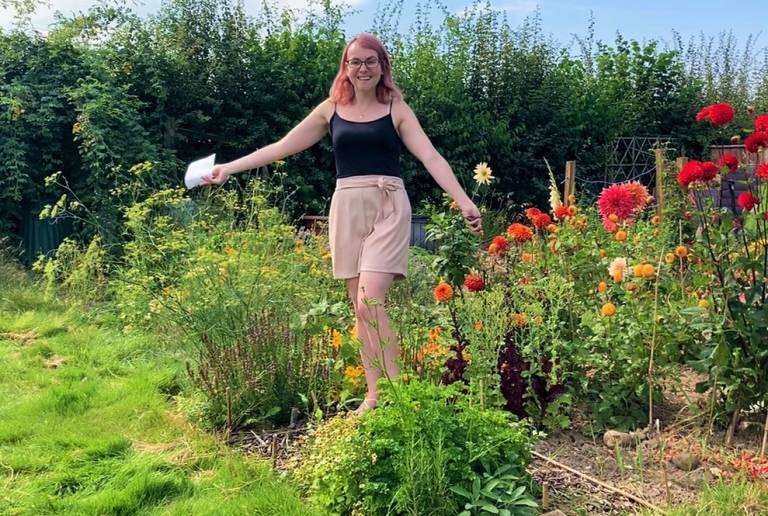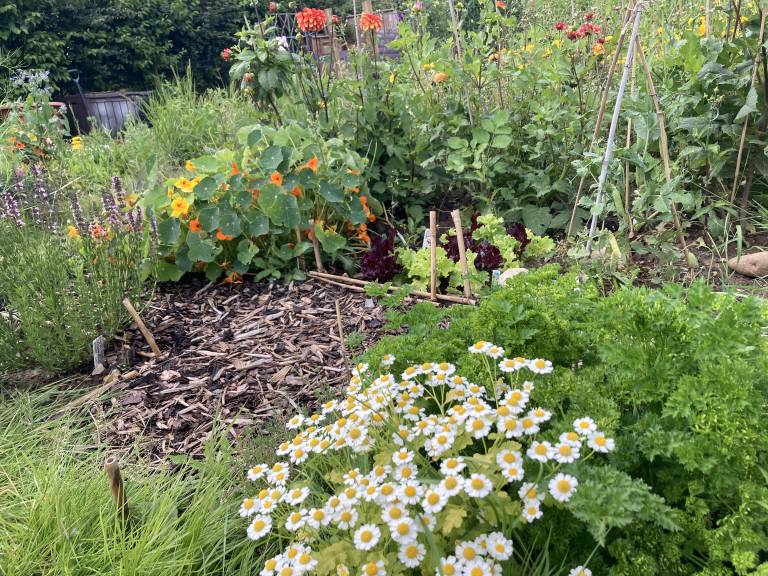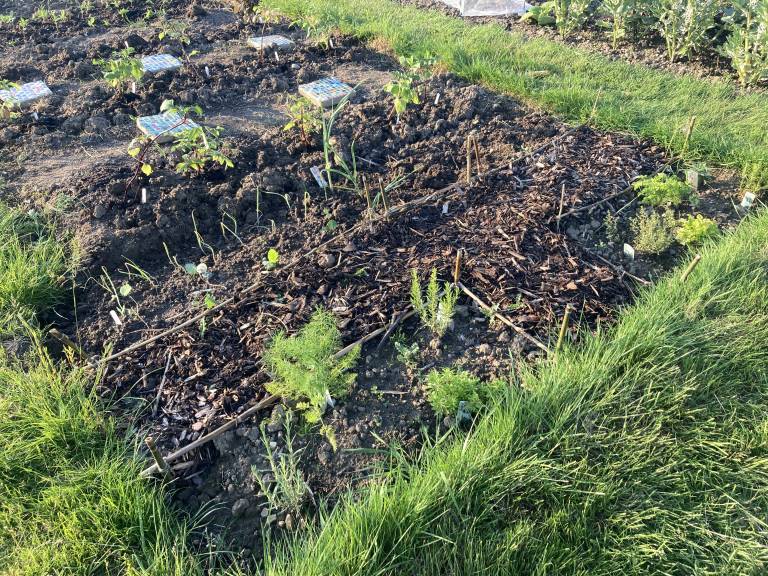ASE's Medieval Garden | 1 | Introduction
24 November 2021
Archaeologist Lorna Webb has been busy this year growing medieval plants in her allotment! Here she introduces a new digital outreach project, featuring blogs and videos about her horticultural and historical adventures.

Introduction
Welcome to ASE's Medieval Garden, a short series of videos and blog posts documenting a season of growing and exploring medieval plants in my allotment!
As a veteran of a Medieval Studies masters at UCL, an archaeologist at ASE, and a keen gardener, it’s no wonder I’m captivated by what the environment looked like in the medieval period, and how people used it.
For the past year I’ve been writing lots of blog posts on the manuscripts, artefacts and archaeological evidence dating from around AD410 to the end of the 1400s. These give tantalising glimpses into a period of great change following the departure of the Romans from Britain. More recently I’ve been inspired to go one further than writing… trying a little medieval gardening of my own!
On my half plot allotment in the Essex countryside I’ve been growing plants found in medieval contexts archaeologically and described in the written evidence of the time. These have included herbs, flowers, vegetables, and even some weeds! Outside the boundaries of the allotment I’ll be looking along hedgerows and even carparks(!) to find medieval staples growing wild.
Through the project we’ll be exploring these plants, many of which are recognisable to us in the modern world, and see how they were used during the medieval period.
What do we know about Medieval Gardens?
Gardens as a concept are not well defined in the medieval period.
Domestic homes would have had an area for growing vegetables and other edible plants, but set gardens were rare.
My example garden is designed around a monastic garden, especially that favoured by the Benedictines. Monastic gardens grew herbs and vegetables and appear on plans and inventories from the time. Gardens from the later medieval period also include rose gardens and flower gardens.

Fully planted garden in August 2021. The regimented separation of different plants (using the bark path in the middle) reflects Benedictine gardening.
What evidence is there for Medieval Gardening?
Medieval manuscripts
One of the best things about the medieval period is the huge resource of written works in both Old English and Middle English dating from the time. When researching the plants to use for this project I looked at manuscripts on subjects such as cookery and medicine where plant names occur.
Some of these sources have already been looked at in some of my previous blogs including recipe books such as The Form of Cury (British Library Add MS 5016).
Other sources include those describing plants for medicine and magic including Bald’s Leechbook (BL Royal 12 D. XVII). Written in Old English around AD900 in Winchester, the Leechbook contains remedies with a large range of plants from herbs to trees for an array of ailments. Some of these I explored in a blog post from last year.
For just medicinal plant use there is the Old English Herbal (BL Cotton MS Vitellius C III). Also known as Pseudo-Apuleius as the text is a copy from a 4th century Roman writer. Written in the 11th century in Bury St Edmunds this herbal has the benefit of having illustrations, giving us the visual prompts to compare the plants to.
For magic as well as medicine, The Lacnunga (BL Harley 585) offers a folk medicine alternative. This unique manuscript is a fascinating mix of folk remedies in Old English, which are usually variations of those found in the Old English Herbal and Bald’s Leechbook. Compiled in AD1000 in Canterbury this group of remedies uses magic and charms invoking both the Christian God and Viking gods!
Archaeological Evidence
It is rare to find the physical remains of a medieval garden. Instead, archaeological evidence for medieval horticulture often derives from bulk-earth samples taken from our sites. These buckets of soil from archaeological contexts are carefully processed back in the lab to ensure delicate artefacts and ecofacts are retained, especially organic material, that might be easy to miss during excavation.
For our purposes, the most important of these are fragments of charcoal and the remains of plants. When analysed by ASE specialists under the microscope these can tell us what plants and weeds were grown or processed in the surrounding area, and what wood species were burnt. Combining this with other archaeological and historical evidence from the site gives archaeologists the best understanding of not only medieval gardening, but the surrounding environment and woodland management at the time.
How to make your own Medieval Garden
Fancy yourself as a medieval gardener? Here’s how I set up my allotment – although you can grow most of these modern day varieties in containers too!
Mark out and prepare your plot (or pots!). My example garden is 2.5m by 1.5m with a bark pathway in a “T” shape. I marked out my small growing area with string and then dug it over removing any weeds. I used bark from my local supermarket to put down a convenient walk way. Beds such as these were very common in monastery and manor house gardens from the middle medieval period.
Plant Out your Plants! This is the best bit of gardening - adding in new plants! These can be ordered online or picked up as plug plants from a garden centre (if you are lazy like me) or grown from seed. In Early June I put in a number of herbs, vegetables and edible flowers as plug plants into the beds around my path way. The types of plants I am growing mostly do not need any technical help and for the most part I let them just do their thing!

Keep them alive! Remember to water your plants regularly especially during hot periods. I also had to net my peas to protect them from hungry pigeons. Unlike the monastic gardens which this is based on I am not on my allotment during the day so prevention methods like netting is an essential in modern gardening.

July 2021. The first plants have been put in with the herbs at the front and the vegetables and flowers at the back. You can see my netted peas at the back.
Conclusion
My Medieval Garden has really shown me how my archaeological interests can enrich my horticultural hobby! Along with the health and wellbeing benefits intrinsic to gardening such as being outside, engaging with nature and keeping active, this extra historical dimension has given me a new perspective on plants I’ve grown or known for years. Hopefully you’ll get a sense of this throughout the project.
Check out our first video, and follow ASE on Facebook, Twitter and Instagram for more posts about the Medieval Garden project.

The garden in full bloom, August 2021.
External Links
The British library has a fantastic collection of digitised manuscripts including:
Bald’s Leechbook http://www.bl.uk/manuscripts/Viewer.aspx?ref=royal_ms_12_d_xvii_fs001ar
The Lacnunga http://www.bl.uk/manuscripts/Viewer.aspx?ref=harley_ms_585_f001r
The Old English Herbal http://www.bl.uk/manuscripts/Viewer.aspx?ref=cotton_ms_vitellius_c_iii_f011r
 Close
Close

